I like to share this presentation of carnatic songs by legendary singer Damal Krishna Pattamal
The songs: 1. Entharani 2. Datsukovalena 3.Sari Evvare 4.Parthasaradhi 5. Nan Oru Vilayattu Bommaiyiah 6. Mapala
It’s DKP at her best! Enjoy!
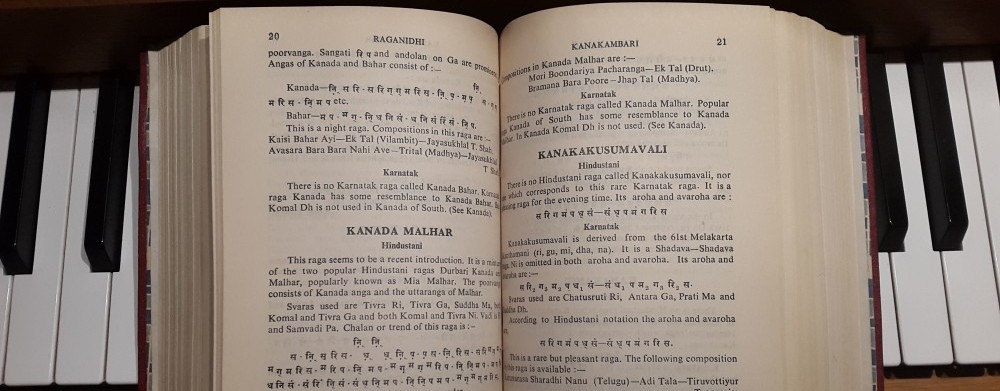
I like to share this presentation of carnatic songs by legendary singer Damal Krishna Pattamal
The songs: 1. Entharani 2. Datsukovalena 3.Sari Evvare 4.Parthasaradhi 5. Nan Oru Vilayattu Bommaiyiah 6. Mapala
It’s DKP at her best! Enjoy!
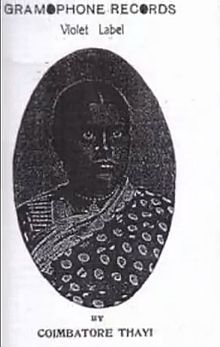
I came across an interesting article by Subha J. Rao in The Hindu about one of the first and most popular recorded female carnatic singers: Coimbatore Thayi (1872-1917). In the article, author-biographer Vikram Sampath tells about his work on reviving Coimbatore Thayi’s legacy as part of a book on female singers.
The British Gramophone Company set foot in South India in 1904 and started recording many artists, among them Coimbatore Thayi, who was one of the most popular singers in Madras. Thayi became a bestselling artist, but she died young – in her mid-forties – in 1917. On approximately 300 discs, “she recorded” – writes Rao – “a rich repertoire of songs, including the compositions of Tyagaraja, Shyama Sastri and Dikshithar, padams, javalis, the Thirupugazh… Sadly, most of them are lost to time. However, some of them can be heard on YouTube and Vikram’s Archive of Indian Music.”
The article in The Hindu takes an interesting turn when the story of Thayi moves to Europe: “She was popular abroad too. In 1911, a French musician Maurice Delage heard her soft, bhakti-filled voice in Paris and was smitten. He wrote to his teacher, Maurice Ravel, about her microtonal effects and variations (gamakas) and voice. “It sent chills up and down my spine”, he wrote. He met Thayi in Madras and even composed two sets of Western music pieces— Quatre Poèmes Hindous, one each dedicated to the cities of Madras, Banaras, Lahore and Jaipur; and a Ragamalika said to be inspired by Thayi’s rendering of an arutpa.”
Martha Angelici sings Maurice Delage’s Quatre Poèmes Hindous
Janet Baker sings Maurice Delage’s Quatre Poèmes Hindous
Today there are some recordings and photos left of Coimbatore Thayi, though very little is known of what her life was like and how she spend her childhood.
Biographer Vikram Sampath summarizes: “Thanks to some existing recordings, we know that she sang her heart out into the horn. And that she had a voice which touched a chord even in faraway Paris.”
For me watching this clip is big fun! The band Secret Chiefs 3 play a piece called ‘Vajra’.
‘Vajra’ by the Secret Chiefs 3 turns out to be a well done, enjoyable cover of veena genius S. Balachander’s sixties-recording of ‘Neethumahima’, a composition in raag ‘Hamsanandhi’, as you can check out in a YouTube-video (below) I published in 2008.
HOME
 Raga Unlimited growth rate figures (click on picture to enlarge)
Raga Unlimited growth rate figures (click on picture to enlarge)
The LinkedIn-group that I run, Raga Unlimited, launched on 12 December 2008, has now 344 members. Anyone interested and registered on LinkedIn can join, that is, after (my) admission (don’t worry, there have been no refusals so far). A lot of knowledgeable people show up in the ranks. 37% works in the music industry and 16% is active in arts & design. In 2011 the group’s membership figure more than doubled, from 150 to 343, that’s an increase of 193 members in one year. Most people joined in May (28x), June (29x) and December (29x). Today, New Year’s Day 2012, I’ve already welcomed one more newbie, so we’re talking about a membership growth rate of 1 per day so far this year :).
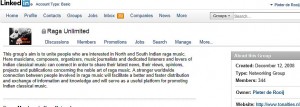
The group’s ‘mission statement’ (click on picture to enlarge)
Feel free to join if you’re interested.
I’ve been tracking down his uploads ever since I noticed his presence on YouTube early this year. Shankar Tucker is quite a phenomenal guy who has conquered a world audience by storm via his YouTubechannel in less than a year.
One of Shankar Tucker’s videos: Sapnon se Bhare Naina, with singer Rohini Ravada
Shankar Tucker plays the clarinet and a handful of other instruments and is interested in Indian Classical music and Indian folk music traditions. He incorporates these different styles with elements of Jazz, Electronic, Classical and Pop in his compositions. He spends a lot of time in India, where he studies Hindustani music on clarinet with flute-bansuri player Pt. Hariprasad Chaurasia. So far Shankar Tucker’s channel has featured collaborations with a bunch of great singers, such as Mahesh Vinayakram, Aditya Rao, Rohan Kymal, Vidya and Vandana Iyer and Nirali Kartik.
Here’s a link to the Hindustan Times writing about him in September 2011, a.o. things saying: “(..) a student of flautist Pandit Hariprasad Chaurasia at the Brindaban Gurukul in Mumbai, he has picked the clarinet over flute”. And then, so funny what follows: “(..) he disclosed in an interview to an Indian Express that his guru doesn’t even know about his fusion experiments.” :))
Earlier today I published a short message on great footage – published on YouTube – of veena player S. Balachander. In addition to this I thought it’d be nice to show a folder used for one of his concerts in the sixties.
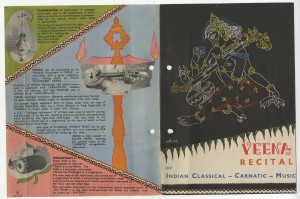
Front- and backpage of the veena recital-brochure (click on the picture to enlarge, twice for extra large)
I found this beautiful veena recital-brochure in the Peter van Hoboken papers at Radio Netherlands, a small, but very fine collection I try to write about now and then.
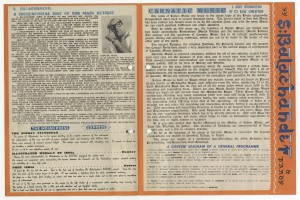
Inside pages of the veena recital-brochure (click on the picture to enlarge, twice for extra large)
I don’t know how Van Hoboken did get this folder, but it seems to me it was either sent to him or he visited a concert of veena maestro S. Balachander himself. Neither the date, nor the location of the concert recital are mentioned, but I guess it was used to inform an audience in India, since the folder was printed in Madras.
OMG, fantaaastic! I can watch this clip all day!!!
Amazing footage of the greatest veena genius, S. Balachander. In this set he’s playing a garland of ragas. There’s some funny moments as well, revealing a bit more of his personality. His playing is monumental and totally unique. Soo inspiring and uplifting to watch this. I think serious, improvising musicians from all over the world – regardless of their musical and cultural background – will easily get inspired by this stupendous veena playing.
This album of Shashank – Flute Fantasia – has been a longtime favourite of mine. For instance the alap of raag Kafi is such a delight to listen to, especially around midnight. Follow this Spotify-link to play this track for free. The rest of this album is delightful as well and can of course be listened on Spotify as well. Highly recommended.
I think this is great, an interview in three parts with brilliant and versatile veena-player Jayanthi Kumaresh, a carnatic artist whose work I’ve been following for years. I hugely admire her playing and I really hope to meet and interview her one day.
Interview – Part One
Interview – Part Two
Interview – Part Three
Groomed so far mainly by famous violinist T.N. Krishnan, this is Charumathi Raghuram, a young carnatic violinist with an excellent technique and in her playing a delightful, refined expression. With great imagination she plays a wonderful rendition of Akhilandeswari and – according to my taste – she achieves the kind of carnatic violin sound that I personally like best and that I always seek for in this music. Also the overall sound, the recording and amplification are ok here I think. I mention this, because many recordings in this area of music sound pretty bad, if not – if I may say so – horrible, that is, in my ears. For instance, I don’t like the use of big reverb and excessive microphone amplification in raga music, as – regrettably – soo often happens on stage or in studios. An interesting topic for debate and for further musicological investigation.